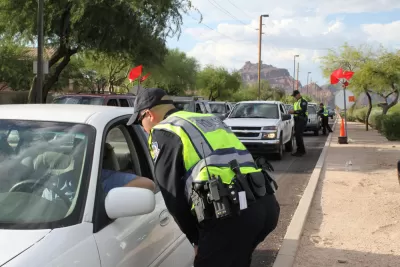The federal government is finally ready to explore technology that could saves thousands of lives every year on the highways and streets of the United States.

"[T]he National Highway Traffic Safety Administration quietly issued a request for information on late- or end-stage automotive technology that detects when drivers are impaired and prevents them from starting their cars," reports Kea Wilson.
The request is a very early preliminary first step toward the potential requirements for automakers to include potentially life-saving devices in vehicles, and, according to Wilson, "it’s a promising sign that the NHTSA is at least exploring the easily available solutions to our national drunk driving epidemic…"
There are many solutions to drunk driving made possible by technology that go far beyond a breathalyzer-actuated ignition. Alcohol detection technologies include on-board sensors to detect alcohol on the driver's breath or on the driver's skin. A concept car made by Nissan includes technology that detects erratic driving behavior consistent with drunk driving.
"But," writes Wilson, "like seatbelts and airbags before them, federal agencies like NHTSA have been reluctant to require the life-saving devices on new vehicles due to pressure from the auto industry, which does not want to pay the costs of implementing the reform."
FULL STORY: Feds to (Finally) Explore Drunk Driving Prevention Tech

Planetizen Federal Action Tracker
A weekly monitor of how Trump’s orders and actions are impacting planners and planning in America.

Map: Where Senate Republicans Want to Sell Your Public Lands
For public land advocates, the Senate Republicans’ proposal to sell millions of acres of public land in the West is “the biggest fight of their careers.”

Restaurant Patios Were a Pandemic Win — Why Were They so Hard to Keep?
Social distancing requirements and changes in travel patterns prompted cities to pilot new uses for street and sidewalk space. Then it got complicated.

Platform Pilsner: Vancouver Transit Agency Releases... a Beer?
TransLink will receive a portion of every sale of the four-pack.

Toronto Weighs Cheaper Transit, Parking Hikes for Major Events
Special event rates would take effect during large festivals, sports games and concerts to ‘discourage driving, manage congestion and free up space for transit.”

Berlin to Consider Car-Free Zone Larger Than Manhattan
The area bound by the 22-mile Ringbahn would still allow 12 uses of a private automobile per year per person, and several other exemptions.
Urban Design for Planners 1: Software Tools
This six-course series explores essential urban design concepts using open source software and equips planners with the tools they need to participate fully in the urban design process.
Planning for Universal Design
Learn the tools for implementing Universal Design in planning regulations.
Heyer Gruel & Associates PA
JM Goldson LLC
Custer County Colorado
City of Camden Redevelopment Agency
City of Astoria
Transportation Research & Education Center (TREC) at Portland State University
Camden Redevelopment Agency
City of Claremont
Municipality of Princeton (NJ)



























